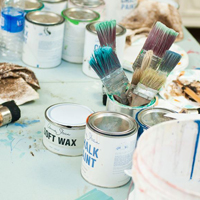Back in the day, I was completely intimidated by the thought of stripping layers of paint and re-staining the wood. To my surprise, it’s much easier than I ever thought possible. With the right chemicals and tools, you can easily strip layers of old paint, varnish in stain in just a matter of minutes.
Our subject piece:
The key is to ensure that what you are stripping is solid wood, like this versatile five-drawer dresser.
I use Klean-Strip, a chemical cleaner. I’ve used the Citristrip, all natural “green” brands and think they totally suck. I’ve never had good luck with them and it’s been way more aggravation than a help. So, this is my brand of choice. Wear gloves (and eyewear) because this stuff burns like crazy if it splatters on your skin. Really…I know from experience. You’re skin will turn bright red and it feels like it is burning right through to the bone! In the meantime, you’re tongue ends up bleeding because you are biting down so hard in an attempt not to curse!
I pour the Klean Strip on liberally and use a cheap, $1 chip brush to spread it around. It doesn’t take long before you will see the paint start to bubble up. Give it a few minutes and use a putty knife to start peeling off the paint. You want to start peeling the paint while the Klean Strip is still wet!
Once you get the first coat of paint off, you usually need to go back over with another round of Klean Strip for the thicker layers that didn’t penetrate. Again, put another liberal coat of Klean Strip on the painted areas and wait for the paint to bubble up. Note: The Klean Strip is prone to splatter along the sides of the piece and the drawers. I strip and re-stain prior to painting the base so I can paint over the areas on the side where it strips off rather than repainting those same areas.
I repeat the process of using the Putty Knife to wipe off the rest of the paint and the top layer of varnish two more times. The third and final time is to get the last little bits of paint and the top layer of varnish.
Again, I put it on pretty liberally…probably more than I need to. But on my last round I’m focusing on the edges and the patches of varnish.
I use the chip brush to spread it around, and for the final time scrape the last layers of varnish and paint with the putty knife.
With the last layer removed, it is ready to be sanded. If you are a professional wood worker, this is where you want to turn away because once I start sanding, I do it all wrong! Consider this your warning!
I only want to sand it once! I use a course, 60-grit sandpaper on my palm sander to clean up the finish that the Klean Strip didn’t get to (although an 80 grit would have been sufficient). Note: The key to easy sanding is to let the sander do all the work. There is no need to apply a lot of pressure on the sander.
Then I apply my first coat of stain. I almost always go straight for the Dark Walnut.
Once your first coat of stain is on, wipe it off fairly soon after you apply it with a cloth. Note: If you don’t wipe off the wet stain, it will look nasty. Think of stain as a medium to penetrate and re-color the wood. Try not to think of it as paint. If you don’t wipe off the excess stain, it will dry streaky and most likely have drip marks along the side, looking like it was painted rather than stained.
Once the first coat is wiped off, this (above) is what it will look like. Now, remember when I told wood workers to look away? Well…I sand incorrectly. REAL furniture re finishers will sand working from a low-grit to a high grit sandpaper. I don’t have time for that and the result of my sanding technique is “sanding swirls.” See the teeny tiny swirlies above in the wood? That is from using a low grit sandpaper with a palm sander and only sanding it one time. Sometimes, those sanding swirls look really cool in finished pieces. But a real woodworking furniture re finisher would cringe.
To “fix,” or rather diminish the sanding swirls, sand the top again with a 220 grit sandpaper once the stain is dry (okay…mostly dry). Re-sanding roughs up the finish just enough so that the second coat of stain can penetrate. Wipe down the dust and stain again.
Once the final coat of stain is dry, go back over with the 220 grit sandpaper and apply Dark Wax (or polyurethane) to protect the finish.
Then commence with painting the base. By now, it will need it!
Check back to see this dresser in all her glory when it’s done. Give it a day or two for a reveal!



Thank you for the info on stripping. I had tried citrasolve and thought it sucked too and returned it. I have been sanding tops, but I can’t always get the previous finish off so I have to give up and paint. I am going to try what you use.
I just found your blog from MMS and I love it!